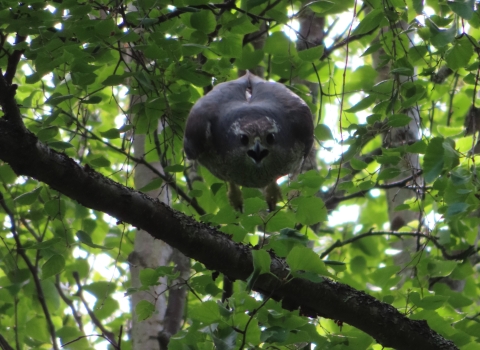Empire, Michigan -- As azure waves lap at a sandy beach at Sleeping Bear Dunes National Lakeshore, Gaby and Goo rest for a minute looking out over the water. They have been coming here every year of their adult lives. But they aren’t summer vacationers admiring Lake Michigan. Gaby and Goo are endangered piping plovers who nest on the very beaches that draw so many tourists.
Unlike the water levels on the Great Lakes, plover recovery efforts are only trending in the right direction. Credit is due to partnerships and community involvement.
With more than 10,000 miles of Great Lakes shoreline, you might think there is plenty of room for these little shore birds to thrive. But habitat degradation and loss pose major threats to piping plover recovery. Plovers need beaches without too much vegetation or disturbance – from people or predators. And the beaches are under siege from over-development, flooding, and fluctuating water levels. Climate change influences the dynamic between plovers and beaches even more.
Climate change impacts on plovers
Historically, plovers were abundant enough that fluctuating water levels weren’t a risk. By the mid-1980s, though, plover numbers nationwide had plummeted. Great Lakes piping plovers have been on the endangered species list since 1986, a year after the Atlantic Coast population was listed as threatened.
Recovery efforts for the Great Lakes population are working, but climate change climate change
Climate change includes both global warming driven by human-induced emissions of greenhouse gases and the resulting large-scale shifts in weather patterns. Though there have been previous periods of climatic change, since the mid-20th century humans have had an unprecedented impact on Earth's climate system and caused change on a global scale.
Learn more about climate change increases the variability and severity of threats. Plover nesting has always been impacted by rising and falling lake levels. More beach is available for nesting when water levels are low.
But high-water levels and scouring by ice are necessary to keep beaches free from vegetation. Storms that temporarily raise water levels can inundate and destroy nest sites. Plovers, though, have adapted to these fluctuations and stick to their preferred beaches even when conditions change.
The rise in severe and unpredictable storms washes nests away and impacts chick survival as exposure to cold and rainy weather leaves the young overly dependent on their parents for brooding. Of particular concern is the first few days of a chick’s life when foraging for food is essential for its survival.
“These plovers are tough,” said Jillian Farkas, piping plover coordinator for the Great Lakes. “They are resilient birds that can withstand some variability, but climate change can throw them some unpredictable curveballs.”
Conservation efforts, including habitat protection, nest monitoring, predator management and, as a last resort, raising the birds in captivity, have all helped stabilize the plover population. The birds are once again nesting on all five Great Lakes.
Farkas cautions, though, that a wait-and-see approach is needed to determine how the birds will respond to climate change.
“We’ve seen chicks hatch four days earlier compared to hatch dates 20 years ago, but it’s unclear if this is the result of climate change and warmer springs,” she said. “As the population rebounds, plovers are nesting on beaches where they haven’t been seen for more than half a century. As we monitor the nesting pairs, we will see if their historic nesting beaches will continue to be re-established.”
Beach use impacts on plovers
Climate change is also a wildcard when it comes to the dynamic between plovers and people. Rising lake levels and fiercer storms may lead communities to build more beach infrastructure – break walls, for example -- which reduces plover habitat. Great Lakes plover populations have been slowly increasing thanks in part to habitat conservation. But it’s likely these efforts will need to continue in perpetuity.
Hotter summers and warmer springs are expected to increase the number of Great Lakes beachgoers, which means more pressure on piping plovers. The plover lifecycle aligns with popular vacation times: plovers hit the beach looking for a nest site during spring break; chicks hatch around Memorial Day; and they fledge near Independence Day.
Great Lakes recovery efforts have already succeeded in engaging local communities in plover conservation. Sleeping Bear Dunes – Gaby and Goo’s home – is a prime example. Towering dunes and crystal-clear water are the first things visitors notice. They must scour the sand, though, to find the well-camouflaged piping plovers. Signs at the trailheads alert beachgoers to plover habitat. Additional measures, like closing beaches to dogs and using chick enclosures, also protect the birds. Many people don’t realize that dogs cause nest abandonment, decreased foraging time, and even death for all ages of piping plovers.
Since 2016, Volunteers in the Bark Ranger Ambassador program have helped visitors avoid important habitat and share the shore with wildlife. Volunteers, and their dogs, serve as ambassadors who model good beach behavior. At pop-up booths, or on the beach, the volunteers educate visitors about proper pet behavior. They also hand out park maps and dog leashes.
“Community engagement works,” said Farkas. “Plover survival is higher when communities are involved and invested in conservation. But what we do in the Great Lakes is only one piece of the plover conservation puzzle, since the birds head to wintering habitat in the South for as many as eight months of the year.”
How to help
Everyone can play a role in plover conservation. Do your part by giving plovers space, keeping dogs on leashes, and supporting conservation efforts that ensure beaches remain dynamic ecosystems.





